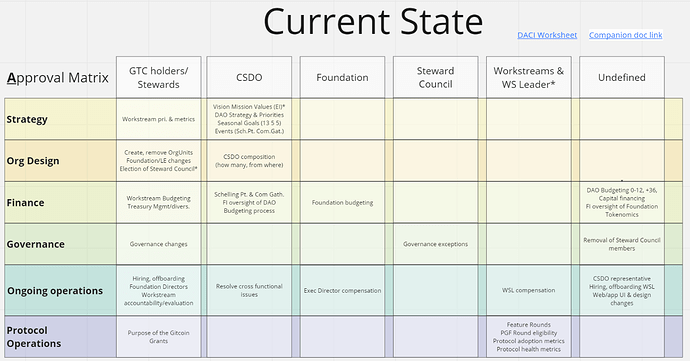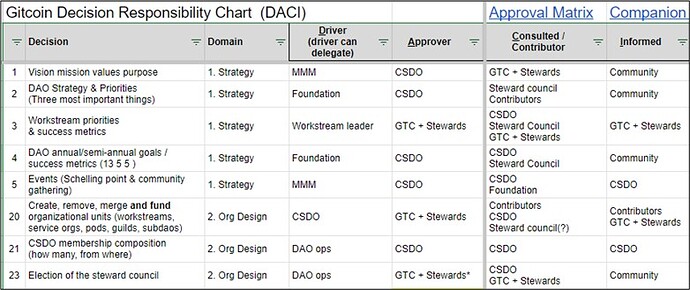As Gitcoin races to deliver the “three most important things” we recognize 1) the organization has changed and 2) we should proactively think about the next phase. For context, @Viriya shared some early thinking on what the future organization could look like. That conversation can be seen shared here with the Steward Council found here.
“Every system is perfectly designed to get the results it gets.” W. Edwards Deming
One approach to the traditional organizational design is defining what decisions need to be made and who is best positioned to make those decisions. In the DAO this is doubly important as it is often not clear 1) what decision must be made 2) who has the right to make the decision and 3) who drives a decision to resolution? Adding complexity, central to DAO governance is the ethos of community input - how do we ensure we have the right level of involvement/input from stakeholders.
This was illustrated in March where we did an exercise to identify the Gitcoin governance pain points. According to CSDO, listed below are the five pain points, and as you might expect, the majority of the governance issues identified by DAO leadership were related to clarifying the decision space. In fact, the only pain point that was tangentially related to defining the decision space was with finding a way to grant better context to our Gitcoin Stewards – so they can help the DAO make better decisions.
Approval matrix and DACI – the platform for change
Using a collection of high context contributors, we were able to list out the potential sticky decisions that need to be made on an ongoing basis at Gitcoin. From there, we grouped those decisions into about six domains which loosely map to traditional functions. These domains are listed on the left column on the left in the diagram below, and the Miro board here. Being frugal, we decided to focus on Strategy, Organizational Design, Finance and Governance. Ongoing operations will require a bit more work and protocol operations is a container we expect to build on as we move beyond the Beta rounds.
Adding to the matrix, we identified five “groups” who made regular decisions for the DAO. From left to right across the top, they are GTC tokenholders/Stewards, CSDO, the Gitcoin Foundation, the Steward Council, and workstreams/workstream leaders. Finally, there are some decisions where the approver is not well defined, or we have not had to make a decision yet. We collected those gaps under “undefined”.
Through a series of investigations and iterations, CSDO was able to agree on who was the “approver” of each of the most important decisions being made within the DAO.
“Optimal governance reduces friction within the organization, increasing impact and productivity.” Simone & Malcom Collins
Going further, we then used the standard DACI model (Driver, Approver, Consulted, Informed) so that we can show the lifecycle of how the decision gets from identification to approval.
The importance of this step is key. While the approver might make the actual decision, the driver often frames the decision to be made and shoulders the burden of the work. To note, the driver can often delegate this work to a person or a sub team. Examples of this could include CSDO delegating work to a sub team. The sub team may do the work, but under the sponsorship and direction of CSDO.
Additionally, the DACI chart defines the relationship between the decision to be made and other stakeholders, who should be consulted or informed once a decision has been reached. We spent less time on these components knowing the hard work was defining the driver and the approver, but as we mature as an organization, solidifying these relationships is part of operational excellence.
Stewards and contributors can use this chart to understand 1) who makes what decision 2) who drives the decision to conclusion and to 3) identify critical decisions which are problematic or need to be defined.
Additionally, we can use the Approval Matrix to identify hot spots that might need a second look. Going back to the left hand column titled “undefined”, we find items like DAO budgeting, oversight of the Gitcoin Foundation, tokenomics, CSDO representation, and hiring / offboarding of workstream leaders, this all could use additional definition.
To identify other hotspots, we should look at each decision and ask:
- Do we have the right group making the right decisions?
- Can we improve performance if we adjust the decision-making structure?
- How does the decision architecture change as we launch Allo, Grants Stack and Passport?
Absent a decision making crisis, this unsexy & preventative work is never likely going to be described as “wow” but it makes our decision architecture transparent, it help us plan organizational structure changes, it can help us avoid a crisis, and it can chart progress towards decentralization.
But, working these kinds of issues are difficult, sticky, and getting to an equitable resolution requires time and a kind of doggedness. So, I would love input from contributors and stewards.
My open questions are:
- Are there any “approvers” on this list that should be changed / challenged?
- How urgent / important is this work to tackle now?
- How might this work help us?
I have my own ideas on the hotspots, which you can find here – but I am interested to hear from stewards and the community as to the decision points you think need to be tackled next – and the urgency of that work. Let us know your thoughts on the three questions above.


